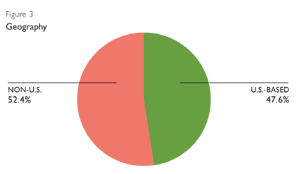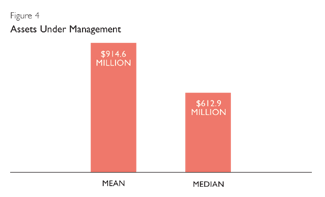Now family offices and the services they offer are more recognized by the mainstream and increasingly desired by the affluent. There is, however, a "wealth threshold" that must be exceeded to warrant the complexity and expense of a single-family model. As a result, the multifamily office, which spreads the costs of expertise, infrastructure and experience among a larger number of families, has broader appeal.
The multifamily model is an extension of the ubiquitous wealth management model that encourages fewer, deeper and more lasting relationships with affluent clients. It focuses on customized solutions, specialized expertise and responsive service.
A Pertinent Business Strategy
Between
2003 and 2008, client assets at U.S. investment advisory firms rose and
fell in conjunction with the markets while interest in the multifamily
office business model increased steadily (Figure 1). Given the
prevalence of asset-based revenues in the advisory field, it's
understandable that business strategies offering a path to more
consistent client relationships and income-irrespective of market and
investment performance-are being given serious consideration.
The top five reasons cited by advisory firms for their interest in the multifamily office structure are interrelated. Most firms anticipate a broader platform of capabilities and high-touch service allows for greater personalization, leading to stronger client satisfaction, higher profitability, greater competitiveness and more qualified referral prospects (Figure 2).
Journey To The Multifamily Office
The
worsening fiscal conditions of the past year have helped to highlight
the flaws inherent in the structure and operations at many financial
institutions. In addition to weathering harsh scrutiny from regulators,
taxpayers and the media, most firms are looking for ways to shore up
existing business and expand. The multifamily office has emerged as a
suitable evolution for an industry that aspires to serve a wealthier
and potentially more profitable clientele.
The following sections explore the changing perspectives and differing practices of professional advisory firms when it comes to the multifamily office business model, including the essential components of a product and service platform, the typical operational and staffing infrastructures, the nature of third-party alliances, and the source and form of revenues and compensation.
About The Research
In
January 2009, we conducted a telephone survey of 103 investment
advisory firms that identify themselves as multifamily offices. Our
sample was roughly split between U.S. and non-U.S. domiciles, with
average assets under management near $1 billion and median assets of
slightly more than $600 million (Figures 3 and 4).
While considering themselves multifamily offices, all the firms in our survey attribute 80% or more of their revenues to asset-based fees that are calculated on each client's total assets under management. Services that carry other compensation structures, such as commissions or flat fees, account for less than 10% of total revenues or are defined as "cost centers" within the organization. Such services are generally treated as loss leaders, helping to round out an undifferentiated product offering and attract new, affluent clients.
These conditions translate to the following:
Average annual revenue: $8.2M
Average annual cost of administrative/lifestyle services: $1.9M
Average annual profits: $6.3M
The Multifamily Office Platform
By
definition, family offices are designed around one or more families'
unique needs and wants. Therefore, they often require a broad cross
section of services. Today's multifamily offices provide a wide range
of capabilities and expertise that falls into three primary categories:
financial, administrative and lifestyle. These three categories
encompass 18 key service offerings (Figures 5, 6 and 7).
The multifamily office model is a rapidly evolving concept. Products and services differ from firm to firm, as do the degrees and style of execution. However, standardization is imminent and leading players have a number of shared characteristics:
Most revenue is derived from investment-related services that are priced as a percentage of assets under management.
A combination of fee structures, including one-time and recurring fees,
transaction fees and commissions, accommodates the vast components of
the platform and allows multifamily offices to generate revenue in
several ways.
All multifamily offices provide asset allocation and investment manager selection for an asset-based fee.
Advanced planning services, such as tax management, estate planning and asset protection, are provided by 95% of firms.
Administrative and lifestyle services are covered as part of an "inclusive" fee for clients with assets above a target level.
More than 80% of firms offer four core administrative services, and the majority of them do so with in-house staff.
The majority of lifestyle services are delivered through alliances with third-party specialty providers.
A Shifting Interpretation
As
competition for the attention and assets of the super-rich mounts, the
multifamily office model offers a more viable and client-focused
platform for companies in search of a new business proposition. From
the client's perspective, it's an effective choice, but it remains
unclear whether this dedicated and highly tailored approach can thrive
under conventional management.
As financial organizations reinvent themselves to retain and attract clients or simply clear the slate of past problems, ultra-high-net-worth families will need more critical guidance to evaluate the firms and the professionals vying for their business. Because of the more holistic approach employed by most family offices, a good fit between a provider and a client will be largely dependent on the depth, breadth and accuracy of an up-front assessment. The handful of advocacy groups and pension consultants that operate at the periphery of the family office industry can offer a subset of the required knowledge, but there will be increasing demand for unbiased specialists.
The changing dynamics of a demanding client base and a rapidly evolving regulatory climate will both play a role in how the multifamily office takes shape in the coming years, as will achieving the appropriate combination of products, services, pricing and resources to deliver sophisticated and inclusive wealth management solutions.
This article was adapted from a spring 2009 report, entitled "The MFO Solution," by Rothstein Kass. For more information or a copy of the report, including the complete research findings, please visit www.rkco.com.





